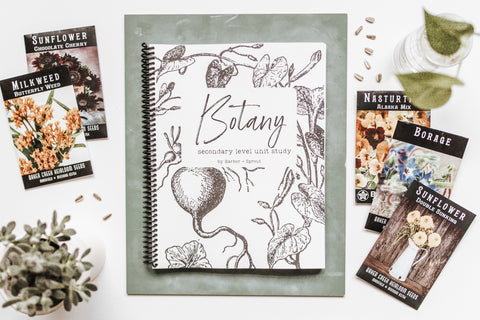
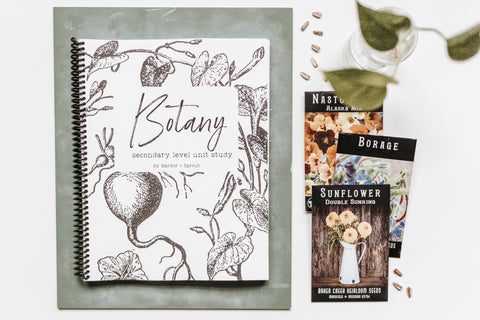
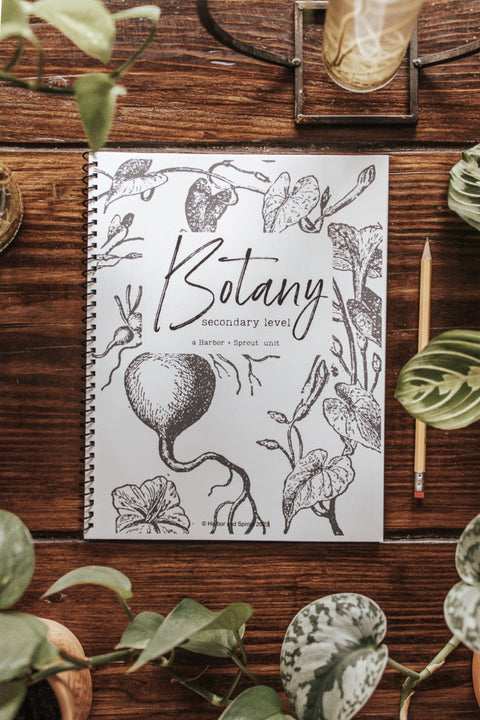
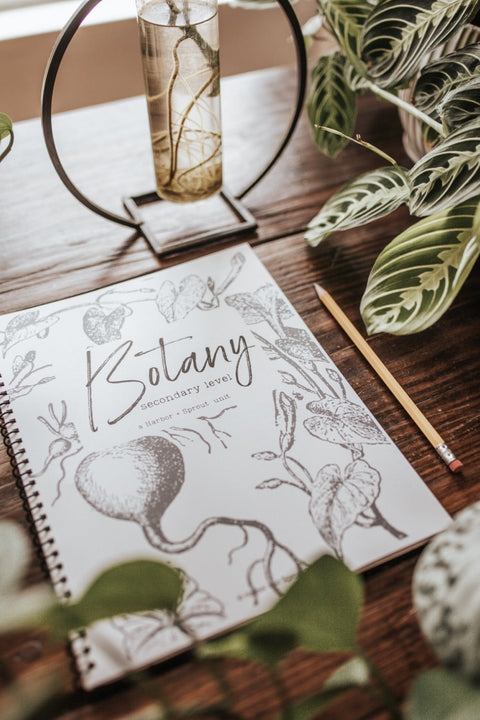
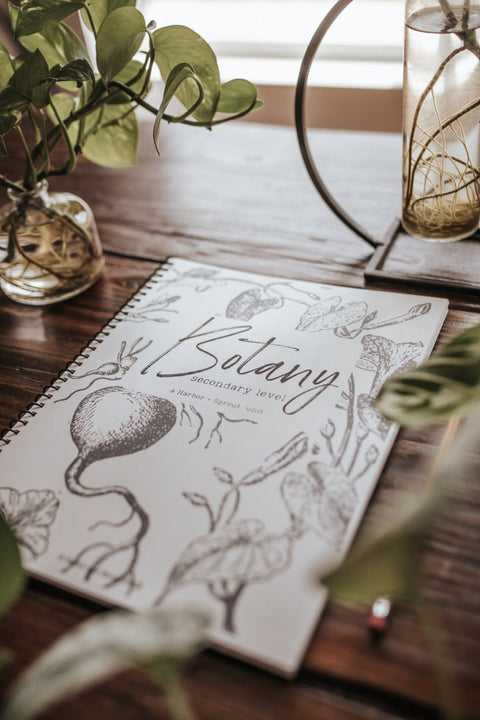
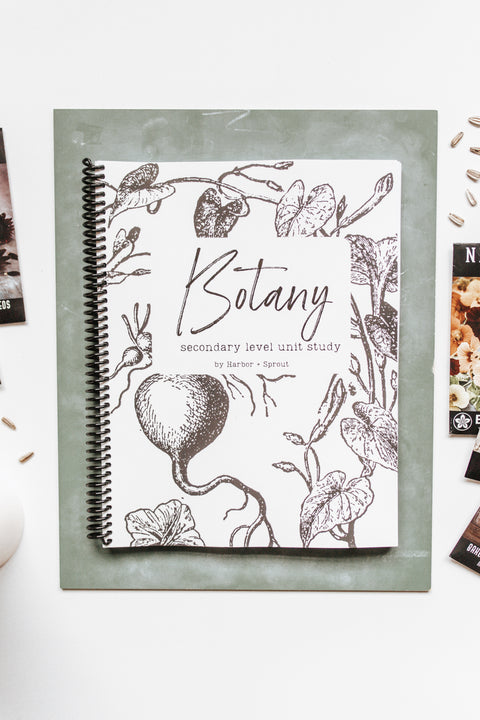
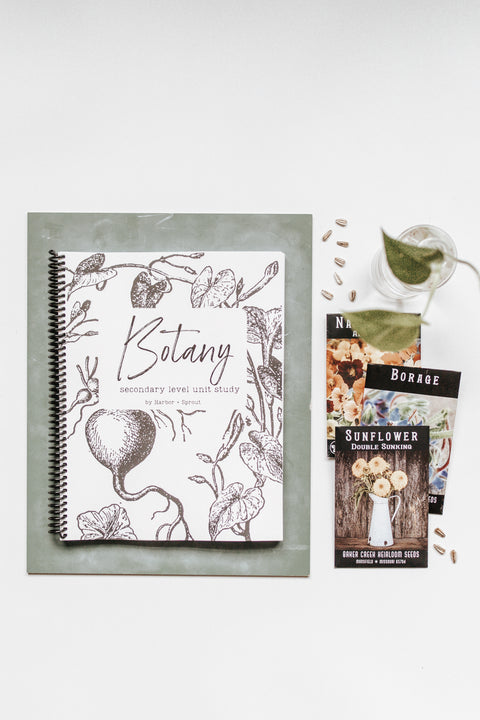
Harbor and Sprout
PRINT Botany Secondary Level Unit Study
Welcome to the Botany Secondary Level Unit Study by Harbor + Sprout! Our upper-level homeschool curriculum is designed to guide you on immersive study experiences, rich with deep-level thinking, research and reflection prompts, and project-based learning. As you work through the modules in this unit study, we encourage you to take your time with the material and activities you choose to complete. In doing so, you will undergo a comprehensive journey through not only the topic at hand, but develop acumen for countless other life skills and tenets of academia. This unit study is intended for middle school and high school students ages 12-18+.
This unit study will be delivered to your door in printed format as a coil-bound, full-color book with a glossy cover ready for use. The book is non-consumable, meaning that writing will be done in a separate notebook or in your preferred Harbor + Sprout Companion Notebook. You can also purchase a digital PDF copy of this unit study here, along with the Harbor + Sprout companion notebook in either digital PDF or physical print format. Please note that once processed, print materials are not eligible for return, refund, or exchange.
This unit includes the following contents and modules:
- Botany Introduction
- Module 1: Plant Anatomy
- Module 2: Cell Structure, Photosynthesis, Life Cycles, & Pollination
- Module 3: Growing Plants- Hardiness Zones, Greenhouses, Hydroponics, & Biodynamics
- Module 4: Plants Around the World
- Module 5: History
- Module 6: Poetry/Poet Study
- Module 7: Art: Natural Dyes and Paints & Impressionism
- Module 8: Music: The Evolution of Wind Instruments & Music Inspired by Nature
- Module 9: Math: Fibonacci Sequence
- Notebooking Pages
- Appendix: Vocabulary Index, Book Recommendations, and Literary Elements Bank
Page count: 155
Click here to purchase the digital PDF version of this unit study.
Click the toggles below to learn more about the structure and contents of our secondary unit modules.
Our secondary level unit studies are created for students aged 12-18 (adults love them too!) with the intention of fostering thriving lifelong learners. This unit study will guide you on an immersive study experience, rich with deep-level thinking, research and reflection prompts, and project-based learning. As you work through the modules herein, we encourage you to take your time with the material and activities you choose to complete. In doing so, you will undergo a comprehensive journey through not only the topic at hand, but develop acumen for countless other life skills and tenets of academia.
Secondary Level Unit Studies are designed to be open-and-go. Each unit includes 8-10 modules that you will work through at a pace that is most comfortable for you. Each module has a different primary focus and noted applications in regard to subject matter, including nature study, science, history, geography, language arts, writing, math, music, art, math, and theme-specific topics. Modules will not be completed in one day; rather, time spent on each module may span a week or more depending on how in-depth you utilize the contents. Each module contains the following sections:
1. Backdrop for Learning: The backdrop for learning is the primary informational section of each module. The information herein has been carefully researched for content and correctness. The backdrop for learning is intended to provide insight into the unit theme as it pertains to a main subject of study (i.e. history or art). This section should be considered a springboard for further exploration as you continue through the module and seek further understanding.
2. Make it Yours- Notebooking: In the Make it Yours section, you will find open-ended notebooking invitations and journaling prompts to act as your guide as you reflect upon the concepts presented in the module and explore your own ideas relative to them. This will be the primary source of your language arts and writing study within the unit.
For students still needing more guidance, you may opt for journaling prompts with a focus on reading comprehension and reflection. Students who are ready for more advanced learning may select more research-based or abstract prompts. If an educator feels that their student needs further writing or language study in their unit studies, notebooking is an excellent way to incorporate more practice.
You may choose to complete as many of the provided prompts in each module as you’d like, and you may employ whatever notebooking style that resonates with you from an extensive list included in the unit study. We encourage you to venture outside your comfort zone and try new and different notebooking and writing styles throughout this unit and beyond! Through this process, you will have the opportunity to take ownership of your understanding of the subjects at hand and to delve deeper into the aspects that fascinate you most.
Notebooking may be completed on the included notebooking pages either printed or in digital form, or you may use a notebook or journal of your own.
3. Bring it to Life: In the Bring it to Life section, you will find hands-on applications and projects intended to further your self-guided learning. This project-based learning will help you form connections with each module’s subject matter within the unit theme. Through hands-on and complex applications, activities, experiences, experiments, and projects, you will have the opportunity to draw connections between the modules and your own world. We have provided several project-based learning prompts within each module that explore the theme from all learning styles, including:
- visual
- auditory
- linguistic
- kinesthetic
- logical
You may choose to participate in as many of the prompts as you’d like. We encourage you to not only find the styles of learning that resonate most with you, but to consider following prompts that you would not naturally gravitate toward in order to foster a wide range of skills and embark on new experiences.
Each of our secondary units has its own page on the Harbor + Sprout website with supplemental content and activity links for you to utilize and expand your study. These resources are organized by module and will help to provide a more well-rounded understanding of the module content. The webpage for each unit is linked within the unit itself.
Appendix: In the appendix section, you will find the following:
- Vocabulary: These are words found throughout the unit that may be new and are particularly relevant to the topic. We encourage you to incorporate these words into your notebooking and projects.
- Literary elements: These are elements and devices you may choose to employ in your notebooking and projects. As a way to further your language arts study, you are encouraged to select one or more literary elements to explore in your work throughout each module.
- References: Sources used in the researching of this unit study. You will find supplemental content and videos on the unit-specific webpage of the H+S website.
This unit is intended for use by students aged 12-18 with varying degrees of independence and complexity. Each child learns at a different pace and has varied preferences, strengths, and struggles. Please consider the following as you tailor this unit study to suit the needs of your unique learner and to help them grow in innovation, independence, and confidence as they work through Harbor + Sprout studies.
Parent/educator involvement: While the goal with our secondary units is to help garner independent learners who desire to share their experiences and discoveries inherently, the process of working through the units, even if it takes multiple years, will help develop those independent learning skills. We recommend determining checkpoints with your child throughout the unit to help guide them along. For example, perhaps you establish a check-in before and after the reading is completed, before and after each notebooking prompt, and before and after each day of work on projects.
Writing level: The writing in these units is advanced by design. It is fitting for the most advanced age group and a challenge for younger learners. Reading comprehension is a skill that takes many years to develop, and the process of working through reading, notebooking prompts, and projects will help foster that development. Notebooking prompts for younger students may focus more heavily on comprehension of the reading while prompts for older students may be more abstract and include self-directed research. The reading is an important aspect of these modules, but there is great value in each piece. We encourage you not to skip any of the sections- reading, notebooking, or project-based learning. Even if your child does not fully comprehend all of the reading, they will certainly glean valuable insight from exposure to the information. Discussion and narration can help aid in comprehension.
Younger learners: Students in the early years of the secondary units will likely require more guidance and parental involvement. You may choose to read the material together, pausing to discuss at the end of each page. You may assign your child to read independently, then discuss the reading with you afterward. Remember that the reading does not all need to be completed in one day. Take your time and set a pace that works well for you. Allow space for your younger children to grow into these units over time.
Notebooking prompts for younger children may focus more heavily on concrete aspects of the information or comprehension of the topic. This type of reflection will help your student internalize the information and practice research skills.
Projects for younger children will likely require more parental involvement. Set your child up for success. Discuss the project or activity, make sure they have what they need to complete their work, and be nearby to help when needed.
More advanced students: Older students or those who are more naturally independent may be able to work through much of the unit independently. However, we still recommend employing touch points to ensure quality and true immersion in the information. Ask your student about the reading, let them show you their notebooking work, and be receptive to any questions or needs that arise. Don’t hesitate to be an active participant in experiments and projects even if your student is capable of doing them alone; learning is to be enjoyed by all!
Focused practice: The primary source of language arts and writing study will occur through the notebooking process. If you feel your child needs more practice at a certain type of writing or literary skill, use the notebooking prompts to your advantage. Assign different styles of writing as you see fit, or expand the writing prompts to include subjects you or your child would like to address. You may opt to assign research and a persuasive essay or written letter about a current event pertinent to the topic, for example. It is at your discretion to magnify specific skills or topics as you recognize the need.
As you work through each module, we invite you to engage in lively discussion about your discoveries and projects with fellow students on the Curio Campsite discussion forum for students. Families holding a Curio membership may simply create a family profile that all members can utilize for discussion.
Harbor + Sprout secondary unit studies can be printed or used digitally on a tablet or e-reader. Notebooking assignments may be completed on the open-ended printable notebooking pages provided or in a notebook of your own.
Make sure to include ample books alongside all your studies. We suggest finding field guides, reference titles, biographical texts, historical fiction, poetry, novels, and all manner of rich literature relevant to the subject at hand and of interest to you.
Vocabulary words and concepts specific to the theme will appear throughout the pages of the unit and will also be listed in the appendix. You are encouraged to study and utilize these concepts and words in your notebooking, research, and activities.
Literary devices are listed in the appendix for students to learn about and employ in their notebooking and projects for further language arts application.
These units are designed to help you and your child thrive in their natural and inherent eagerness to learn. By working through these modules and fully engaging with the material, notebooking prompts, and activities, you will witness the development of voracious learners who are curious about the world around them, keen to learn more, and capable of discovery. A myriad of academic and life skills will be applied and refined as connections are made. Allow the process to unfold and enjoy the journey.
